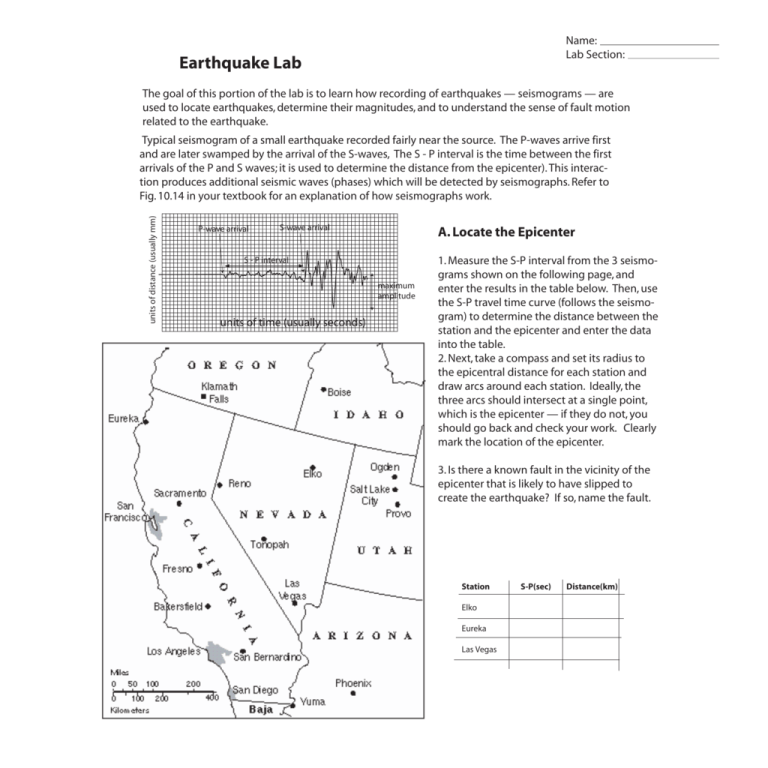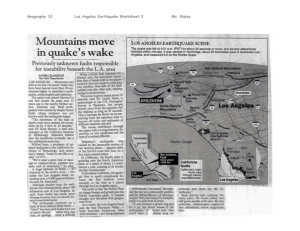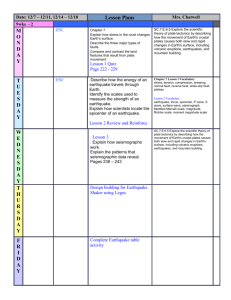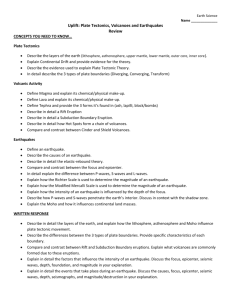Earthquake Lab
advertisement

Name: Lab Section: Earthquake Lab The goal of this portion of the lab is to learn how recording of earthquakes — seismograms — are used to locate earthquakes, determine their magnitudes, and to understand the sense of fault motion related to the earthquake. units of distance (usually mm) Typical seismogram of a small earthquake recorded fairly near the source. The P-waves arrive first and are later swamped by the arrival of the S-waves, The S - P interval is the time between the first arrivals of the P and S waves; it is used to determine the distance from the epicenter). This interaction produces additional seismic waves (phases) which will be detected by seismographs. Refer to Fig. 10.14 in your textbook for an explanation of how seismographs work. P-wave arrival S-wave arrival A. Locate the Epicenter S - P interval maximum amplitude units of time (usually seconds) 1. Measure the S-P interval from the 3 seismograms shown on the following page, and enter the results in the table below. Then, use the S-P travel time curve (follows the seismogram) to determine the distance between the station and the epicenter and enter the data into the table. 2. Next, take a compass and set its radius to the epicentral distance for each station and draw arcs around each station. Ideally, the three arcs should intersect at a single point, which is the epicenter — if they do not, you should go back and check your work. Clearly mark the location of the epicenter. 3. Is there a known fault in the vicinity of the epicenter that is likely to have slipped to create the earthquake? If so, name the fault. Station Elko Eureka Las Vegas S-P(sec) Distance(km) Las Vegas, Nev Elko, Nev Eureka, Ca P waves travel between 6 and 13 km/sec. S waves are slower and travel between 3.5 and 7.5 km/sec. In most regions, study of numerous earthquakes with well-known epicenter locations results in an empirical S-P curve, such as the one shown to the right. B. Magnitude of the Earthquake The magnitude of an earthquake provides a convenient measure of its size scaled to a small number usually less than 9. It is a unitless number, derived from the amplitude of ground motion associated with S-waves, adjusted for the distance between the epicenter and the seismograph station (the amplitude generally drops off with distance from epicenter). The table below helps puts earthquake magnitudes into perspective. Richter M ag ni tude -1.5 1.0 1.5 2.0 2.5 3.0 3.5 4.0 4.5 5.0 5.5 6.0 6.5 7.0 TN T for Sei smi c En erg y Yield 6 ounces 30 po un ds 320 poun ds 1 ton 4.6 ton s 29 ton s 73 ton s 1,000 ton s 5,100 ton s 32,000 ton s 80,000 ton s 1 million ton s 5 million ton s 32 million ton s 7.5 8.0 8.5 9.0 10.0 160 million ton s 1 billion ton s 5 billion ton s 32 billion ton s 1 trillion ton s 12.0 160 trillion ton s Exa mple Brea king a ro ck on a l ab ta ble La rge Blast at a Co nstru ction Site La rge Qua rry or Min e Blast Sma ll Nuclear Wea pon Average Torna do (total energ y) Little Skul l Mtn., NV Qua ke, 1992 Dou ble Spri ng Fla t, NV Qua ke, 1994 No rthri dge , CA Qua ke, 1994 H yogo-Ken Na nb u, Jap a n Q ua ke, 1995 ; Large st The rmonuclear Wea pon Lan ders, CA Qua ke, 1992 Sa n Fr ancisco, CA Q ua ke, 1906 Anch or age, AK Qua ke, 1964 Chi lea n Qua ke, 1960 Sa n-An drea s typ e fault circling Earth (NOT POSSIBL E); OR small asteroid impact Fa ult Ea rth in half throug h c enter(NOT POSSIBL E); OR Ear th's daily receipt of solar energ y modified from John Louie, U. Nevada Reno Seismology Lab B. Magnitude of the Earthquake 1. Measure the maximum amplitude of the S-waves from the 3 seismograms, and enter the results in the table below; add the distances from epicenter you obtained in the previous problem. 2. Then, use the graphical device to the right (called a nomogram) to determine the Richter magnitude of the earthquake as indicated by each of the three seismograms. Ideally, they should all converge on a single answer — if they do not, you should go back and check your work. Station Distance from Epicenter (km) Max S-wave Amplitude (mm) Magnitude Elko Eureka Las Vegas C. Recurrence Time of the Earthquake The North American Plate and the Pacific plate are moving past each other at about 5 cm/yr, but this slip is distributed along many separate faults. The best estimate for the section of the San Andreas of interest here is 14 mm/yr. Use the typical slips in the table to the right to estimate the approximate recurrence interval for an Magnitude earthquake of this magnitude. Avg. Slip 8 4m 7 1.4 m 6 40 cm 5 10 cm C. Focal Mechanism of the Earthquake Earthquake waves spread out from a point where the rupture and displacement first begin — this point is called the hypocenter or the focus of the earthquake (the epicenter is the place on the surface directly above the focus. There is a distinctive pattern of first motion right around the focus, as shown below. 3D View of a Left-Lateral Strike-Slip Fault pulls away from adjacent rock, causing dilation pushes into adjacent rock, causing compression Enlarged View of Focal “Point” View from Above Surface dilational first motion compressional first motion front of first P-wave auxiliary plane dilational first motion compressional first motion fault plane in gray pushes into adjacent rock, causing compression pulls away from adjacent rock, causing dilation epicenter fault plane As shown in the above diagrams, the nature of the first P-wave varies from compressional to dilational as it radiates out into the four quadrants originating from the focus. Seismograms can detect this sense of motion and is recorded as either up upward first motion for compression and a downward first motion for dilation. By studying the map-view pattern of first motion recorded at various stations, you can define the four quadrants, which in turn indicate the sense of motion along the fault when the earthquake occurred. 1. Study the seismograms on the next page and determine whether the first motion is compressional or dilational, then transfer that information onto the map; darken compressional stations and draw a thin vertical line through dilational stations. 2. Based on your interpretations, find the approximate auxiliary plane and shade the compressional quadrants, then shown the relative sense of motion along the -122˚55' -121˚15' fault with some arrows. 37˚55' 4 3 u Fa ard yw Ha 1 Sa lt nd nA 5 a re 11 au sF 2 7 lt 6 8 9 10 12 36˚15' D. The Global Pattern of Seismicity and Plate Tectonics Caribbean Plate Cocos Plate 7.0 nic lca Vo p Ga -C hi Nazca Plate le R Volcanic Gap 5.9 Chi South American Plate le nch Tre 1. Study the seismicity along the South American margin. Based on the seismicity, does the subducting plate appear to be continuous or discontinuous (in both horizontal and vertical, or down-dip, directions)? Describe your observations that lead to your answer. u Per Seismicity occurs where rocks are being deformed under brittle ( breakable, susceptible to failure by fracturing rather than ductile flow, like silly putty) conditions, so the global distribution of reveals where deformation is occurring. As you all know by now, most seismicity is concentrated along plate boundaries, but there is quite a bit more that can be gleaned from a closer inspection of the locations of seismicity. We have loaded a huge database of earthquake foci or hypocenters onto the Geowall computer to help you see the patterns of seismicity in 3D . The questions below refer to the sub-scene called South America. Your lab assistants will show you how to start up the seismicity display. Working with your partner, study the various scenes and write short answers to the following questions. idg e Antarctic Plate 2. a) What is the approximate relationship between the location of volcanism on the overriding plate and the dip and depth of subduction? b) Are there any differences in the subduction zone beneath the two volcanic gaps? How might these differences account for the lack of volcanism. 3. Note that all of the seismicity is not confined to the subducting plate. How might you account for the seismicity that is not in or near the subducting plate?







